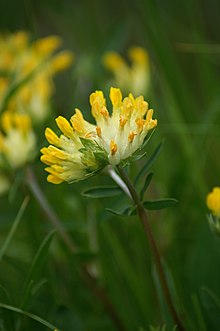Genus of legumes
Anthyllis genus of flowering plants in the family Fabaceae . This genus contains both herbaceous and shrubby species and is distributed in Europe, the Middle East and North Africa. The most widespread and familiar species is A. vulneraria grassland flower which has also been introduced to New Zealand.
Anthyllis species are used as food plants by the larvae of some Lepidoptera species including the following case-bearers of the genus Coleophora C. acanthyllidis , C. protecta (both feed exclusively on A. tragacanthoides ), C. hermanniella (feeds exclusively on A. hermanniae ), C. vestalella (feeds exclusively on A. cytisoides ) and C. vulnerariae (feeds exclusively on A. vulneraria ).
Species
Anthyllis comprises the following species:[2] [3] [4] [5]
Section Anthyllis [ edit ] Anthyllis lemanniana Lowe Anthyllis vulneraria L.
subsp. abyssinica (Sagorski) Cullen
subsp. ajmasiana (Pau) Raynaud & Sauvage
subsp. alpestris (Hegetschw.) Asch. & Graebn.
subsp. alpicola (Brugg.) Gutermann
subsp. argyrophylla (Rothm.) Cullen
subsp. arundana (Boiss. & Reut.) Vasc.
subsp. atlantis Emb. & Maire
subsp. balearica (Coss. ex Mares & Vigin.) O. Bolos & Vigo
subsp. boissieri (Sagorski) Bornm.
subsp. borealis (Rouy) Jalas
subsp. bulgarica (Sagorski) Cullen
subsp. calcicola (Schur) Simk.
subsp. carpatica (Pant.) Nyman
subsp. colorata (Juz.) Tzvelev
subsp. corbierei (Salmon & Travis) Cullen
subsp. fatmae Font Quer
subsp. forondae (Sennen) Cullen
subsp. fruticans Emb.
subsp. gandogeri (Sagorski) Maire
subsp. hispidissima (Sagorski) Cullen
subsp. iberica (W.Becker) Jalas
subsp. iframensis Cullen
subsp. insularum (Rothm.) Romo
subsp. lapponica Hyl.
subsp. lusitanica (Cullen & P. Silva) Franco
subsp. maritima (Hagen) Corb.
subsp. matris-filiae Emb. & Maire
subsp. maura (Beck) Maire
subsp. microcephala (Willk.) Benedi
subsp. nivalis (Willk.) Rivas Mart. & al.
subsp. pindicola Cullen
subsp. polyphylla (DC.) "Nyman, p.p."
subsp. praeporea (A. Kern.) Bornm.
subsp. pseudoarundana H. Lindb.
subsp. pulchella (Vis.) Bornm.
subsp. pyrenaica (Beck) Cullen
subsp. reuteri Cullen
subsp. rifana (Emb. & Maire) Cullen
subsp. rubriflora (DC.) Arcang.
subsp. saharae (Sagorski) Maire
subsp. sampaiana (Rothm.) Vasc.
subsp. schiwereckii (DC.) Tzvelev
subsp. stenophylloides Cullen
subsp. vitellina (Velen.) Kuzmanov
subsp. vulneraria L.
var. font-queri (Rothm.) Cullen
var. macedonica (Degen & Dörfl.) Micevski & Matevski
var. vulneraria L.
subsp. vulnerarioides (All.) Arcang.
subsp. weldeniana (Rchb.) Cullen Section Barba-Jovis [ edit ] Anthyllis aurea Welden Anthyllis barba-jovis L. Anthyllis hermanniae L. Anthyllis hystrix (Barcelo) Cardona & al. Anthyllis splendens Willd. Section Cornicina [ edit ] Anthyllis circinnata (L.) Savi Anthyllis cornicina L. Anthyllis hamosa Desf. Anthyllis lotoides L. Section Dorycnioides [ edit ] Anthyllis onobrychoides Cav. Anthyllis polycephala Desf. Anthyllis ramburii Boiss. Anthyllis rupestris Coss. Anthyllis tejedensis Boiss.
subsp. plumosa (E. Domínguez) Benedí
subsp. tejedensis Boiss. Anthyllis warnieri Emb. Section Oreanthyllis [ edit ] Anthyllis lagascana Benedi Anthyllis montana L.
subsp. atropurpurea (Vuk.) Pignatti
subsp. hispanica (Degen & Hervier) Cullen
subsp. montana L.
subsp. jacquinii (A.Kern.) Hayek Section Terniflora [ edit ] Incertae Sedis [ edit ] Anthyllis aegaea Turrill Anthyllis coccinea (L.) Beck Anthyllis fennica (Jalas) Akulova Anthyllis hegetschweileri (Hegetschweiler-Bodmer) Brügger Anthyllis henoniana Coss. Anthyllis hispidissima (Sagorski) W. Becker Anthyllis langei (Jalas) G. H. Loos Anthyllis pallidiflora (Jord. ex Sagorski) Prain Anthyllis polyphylloides Juz. Anthyllis variegata Grossh. Anthyllis webbiana Hook.
Species names with uncertain taxonomic status
The status of the following species is unresolved:[5]
Anthyllis adriatica Beck Anthyllis alpina G.Don Anthyllis argentea Desv. Anthyllis argentea Salisb. Anthyllis aspalathoides L. Anthyllis asphaltoides L. Anthyllis baldensis A.Kern. ex Sagorski Anthyllis bicephalos Gilib. Anthyllis bicolor Bertol. Anthyllis bicolor Bertol. ex Colla Anthyllis bicolor Dalla Torre & Sarnth. Anthyllis bidentata Munby Anthyllis biflora Sol. Anthyllis caucasica (Grossh.) Juz. Anthyllis chelmea Rothm. Anthyllis cherleri Brügger Anthyllis cicerifolia Pourr. ex Colmeiro Anthyllis circinnata (L.) D.D.Sokoloff Anthyllis collina Salisb. Anthyllis communis Rouy Anthyllis cretica Lam. Anthyllis cupensis Lam. Anthyllis densifolia Formánek Anthyllis depressa Lange Anthyllis dinarica Beck Anthyllis expallens Dalla Torre & Sarnth. Anthyllis flava Gouan Anthyllis fuersteinii Murr Anthyllis genistoides Dufour Anthyllis glaucescens Kit. Anthyllis gracilis Salisb. Anthyllis guyoti Chodat Anthyllis herzegovina Sagorski Anthyllis heterophylla L. Anthyllis hosmarensis Pau Anthyllis hystrix (Willk. ex F. Barcelo) M. A. Cardona, J. Contandriopoulus & E. Sierra Anthyllis indica Lour. Anthyllis italica Loudon Anthyllis jancheniana K.Malý ex Asch. & Graebn. Anthyllis kerneri Sagorski Anthyllis kosanini Degen Anthyllis lateriflora Pau Anthyllis leguminosa Gray Anthyllis linifolia L. Anthyllis lybica Rothm. Anthyllis macrocarpa Walp. Anthyllis media Pau Anthyllis mogadorensis Rothm. Anthyllis moncephalos Gilib. Anthyllis montana subsp. jacquinii (Rchb. f.) Rohlena Anthyllis multicaulis (Lam.) Pau Anthyllis numidica Coss. & Durieu Anthyllis occidentalis Rothm. Anthyllis onoides Burm.f. Anthyllis oreigenes Dalla Torre & Sarnth. Anthyllis pallida Opiz ex Nyman Anthyllis pentaphylla Steud. Anthyllis pseudo-arundana H. Lindb. Anthyllis pseudoarundanum H.Lindb. Anthyllis pseudo-cytisus Walp. Anthyllis pseudo-vulneraria Sagorski Anthyllis pubescens Stokes Anthyllis quinqueflora L.f. Anthyllis rubra Gouan Anthyllis rubriflora (Ser.) Degen Anthyllis rubriflora Hegetschw. Anthyllis rustica Mill. Anthyllis rusticana Wender. Anthyllis sanguinea Schur Anthyllis sericata Chatenier ex Rouy Anthyllis serpentini Bruegger ex Sagorski Anthyllis subdinarica Sagorski Anthyllis tangerina Pau Anthyllis tenuicaulis (Sagorski) Fritsch Anthyllis tirolensis Dalla Torre & Sarnth. Anthyllis tournefortii Schult. ex Steud. Anthyllis variicolor Jeanj. Anthyllis variiflora Dalla Torre & Sarnth. Anthyllis versicolor Dalla Torre & Sarnth. Anthyllis visciflora L.f. Anthyllis vulneraria subsp. balearica (Coss. ex Marès & Vigin.) O.Bolòs & Vigo Anthyllis vulneraria subsp. boscii Kerguelen Anthyllis vulneraria subsp. dertosensis (Rothm.) Font Quer Anthyllis vulneraria subsp. multifolia (W.Becker) O.Bolòs & Vigo Anthyllis vulneraria subsp. nana (Ten.) Tammaro Anthyllis vulneraria subsp. saharae (Sagorski) Jahand. & Maire Anthyllis vulneraria subsp. vulneraria var. bulgarica (Sagorski) Micevski & Matevski Anthyllis vulneraria subsp. vulneraria var. nana Ten. Anthyllis vulneraria subsp. vulneraria var. rubriflora DC. Anthyllis vulnernarioides Bonj. ex Reichb. Hymenocarpos nummularius (DC.) G. Don [6] Hymenocarpos radiatus (L.) Cav. [6] Hymenocarpos radiatus Link [6]
Hybrids
The following hybrids have been described:[5]
Anthyllis ×baltica Juz. ex Z.V.Klochkova Anthyllis ×cazulensis Rivas Goday & Esteve Chueca Anthyllis ×currasii P.P. Ferrer, Roselló & Guara (= Anthyllis cytisoides (Lag.) Pau × Anthyllis lagascana Benedí )[7] Anthyllis ×fortuita Guara & P.P.Ferrer Anthyllis ×polyphylloides Juz. 